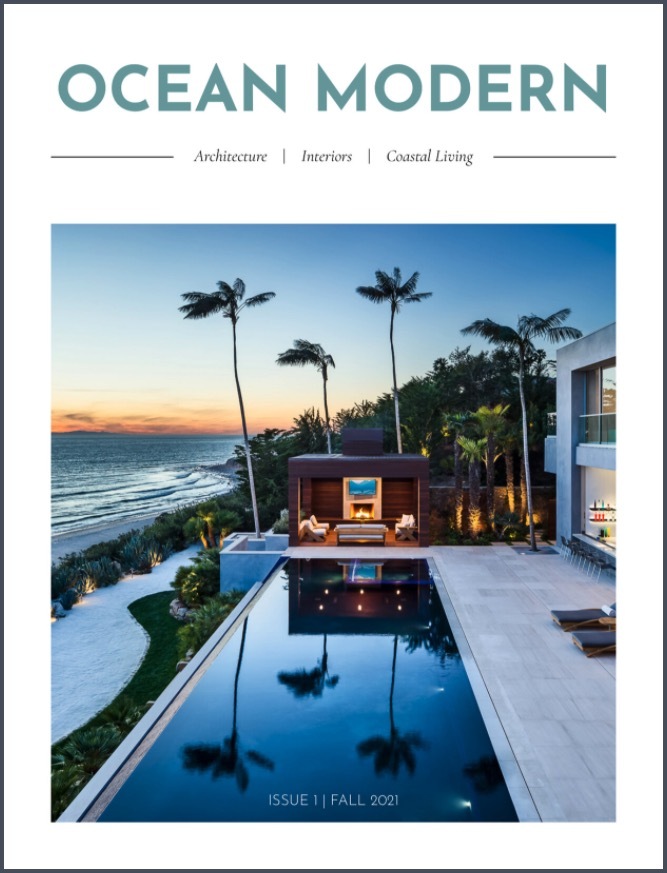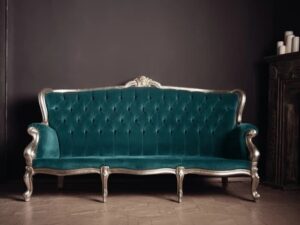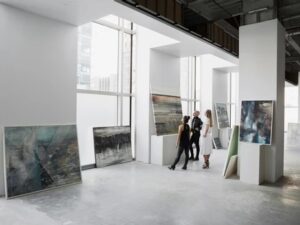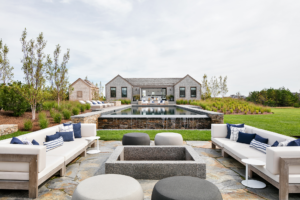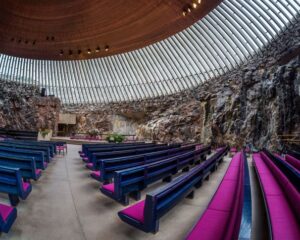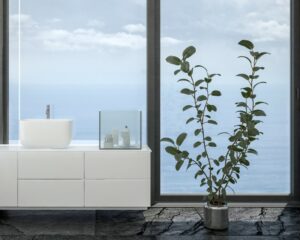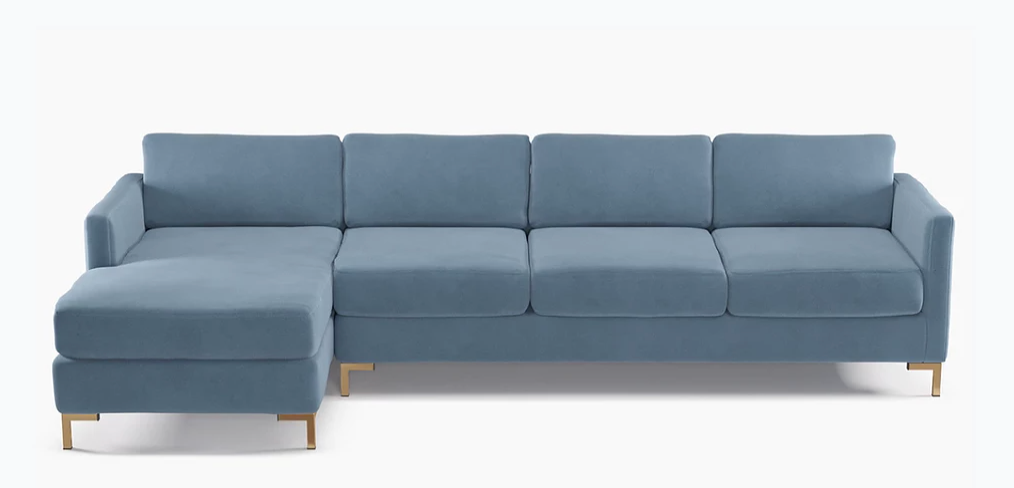
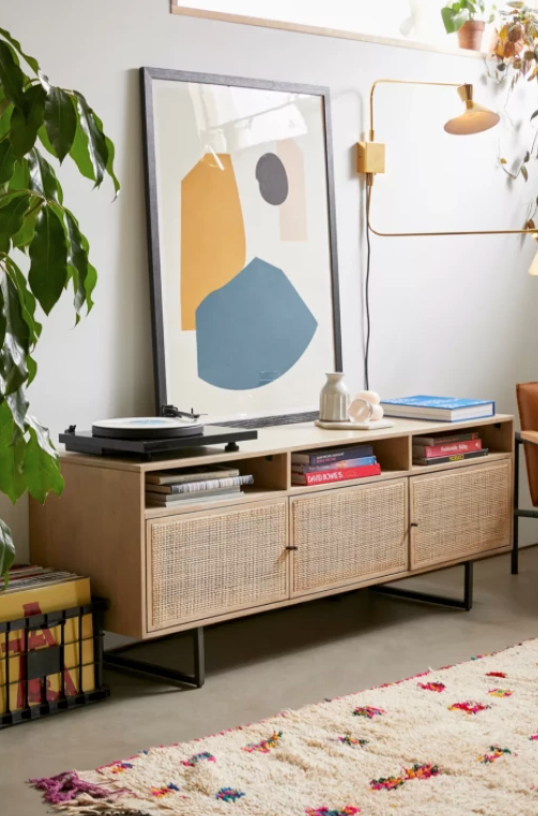
Ocean Modern Sectional – The Inside and Ivy Media Console – Urban Outfitters
As we transition from Summer to Fall, and from Fall to Winter, our interiors change with us. We swap out curtains, trade in table linens and change up the throw pillows on our sofas. We rarely change out our furniture — aside from dusting off or putting away those pieces in the backyard or on the patio. In light of the pandemic’s consequences — social distancing, self-quarantine, and remote work — our interiors have seen a bit more of us in recent months. Also in light of the pandemic, we have a better understanding as a population about the effects of indoor air pollution. As such, we are paying better attention to the quality of materials that make up each piece in our homes. Many of us are searching for healthy, safe furniture that will enrich the atmospheres of each room. Follow below for our top selections for coastal modern furniture poised to transition your home through the Fall and Winter seasons. Read on, too, for further reflection on how the pandemic has influenced interior decorating.
Sleeping, Socializing, and Working from Home
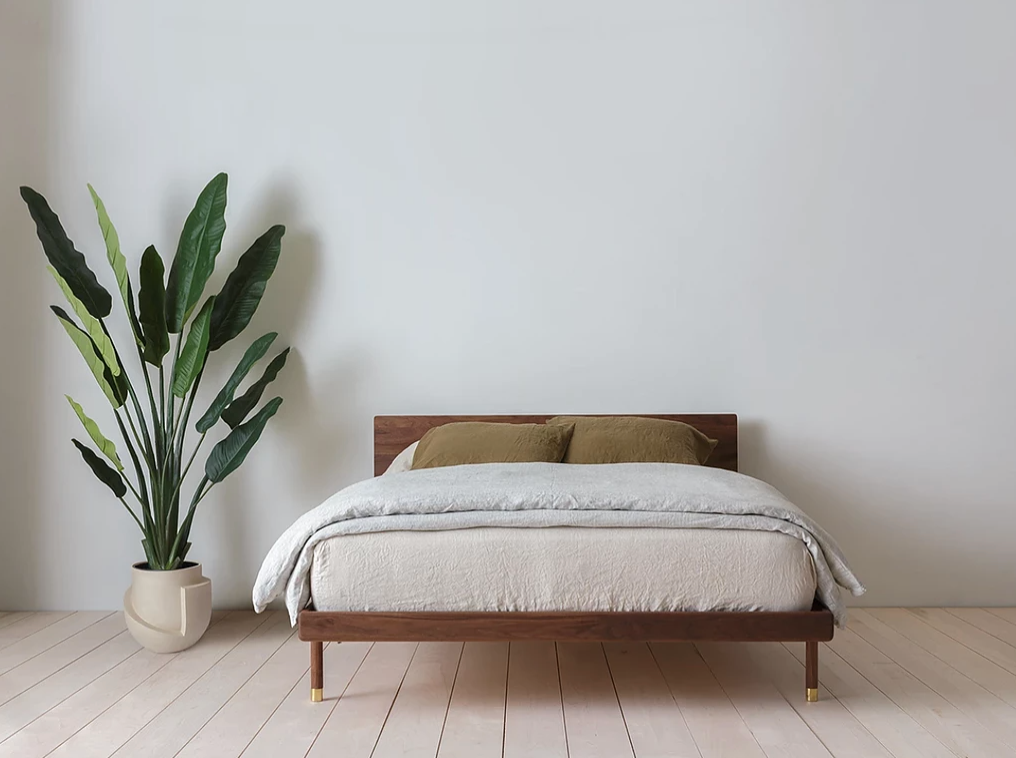

Walnut Simple Bed – Horne and 1949 Protractor Desk – Kardiel
The COVID-19 pandemic has sequestered many of us in our homes for the short term. It has also shifted our understanding of American culture. This shift is likely for the long term. For decades, our country has been one of “commuters.” According to US Census Bureau data from 2017, “85.4 percent of [US workers] drove to their workplace in an automobile.” This statistic “comes down to 128 million people.” In fact, two years ago in 2018, the average commute time for the American worker climbed to an all-time high. Christopher Ingraham explains in his 2019 article “Average commute time reached a new record last year” for The Washington Post.
Ingraham writes that “the average American commute grew to over 27 minutes one way in 2018, a record high.” This is according to data released in September by the U.S. Census Bureau. Ingraham points out that the average addition of two minutes to each one-way commute might not seem like much. However, this increase meant that — until the pandemic — “the typical commuter spent 20 more minutes a week commuting than they did a decade ago.” Now, our culture has shifted. Almost half of all American workers are remote, with few planning to return to full-time in-office work in the near future.
According to economist Nicholas Bloom, the last few months have seen “42 percent of the US labor force” shift to working from home full-time. In a few short months, the US economy has become a “working-from-home economy.” The economy has never functioned as such in part because of the stigma associated with remote work. However, that stigma has disappeared. Today, “a number of corporations are developing plans for more work-from-home-options beyond the pandemic.” In fact, one study has indicated that the share of “working days spent at home [may] increase fourfold from pre-COVID levels.” With “almost twice as many employees working from home as at work,” our culture has rapidly changed in less than a year. This has impacted the way we interact with co-workers, family members, and with our homes.
The Significance of Natural Materials in the Home

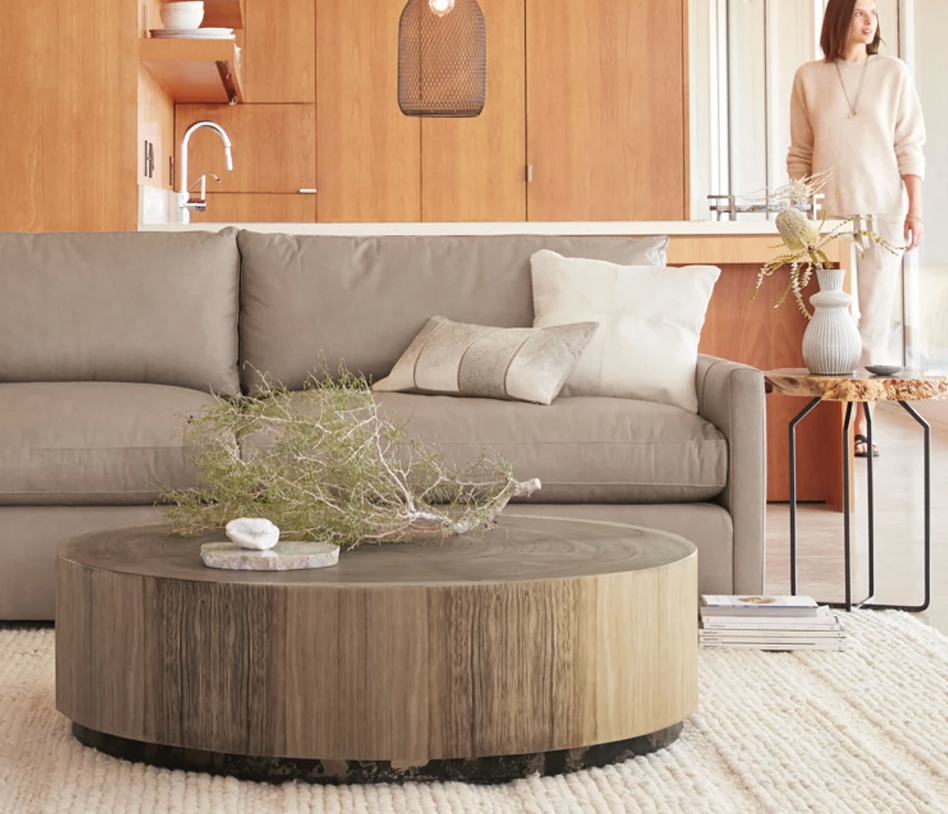
Wordsmith Recliner – Arhaus and Toluca Coffee Table – Arhaus
The pandemic has also outlined the importance of healthy materials in the home by impressing upon us the significance of indoor air quality. Many have turned towards natural, sustainable building and furniture materials as a result. Americans have begun a shift towards these materials in order to clear their homes of volatile organic compounds and other harmful pollutants. As the weather cools down and the option to open windows to refresh interior spaces disappears, choosing quality materials becomes even more vital. According to the article “The advantages of using natural building materials” published by Urbane Eco, the use of natural materials in furnishings is significant. The site explains that they are “a vital aspect of creating a sustainable, healthy home for the occupants and the environment.”
Natural, organic materials release fewer toxins than mass-produced pieces, as they are made without the inclusion of polymer plastics or mixed-material fiber boards. True wood, naturally occurring metals, and other organic materials do not off-gas the way synthetic materials do. Neither do they produce the offensive odors of cheap furnishings or finishings. As such, natural materials prevent an interior’s environment from being polluted with VOCs like formaldehyde and benzene. Exposure to natural materials within the home is not only important for air quality, but can also impact mood and psychological health. Madhuleena Roy Chowdhury, BA in her article “The Positive Effects Of Nature On Your Mental Well-Being” for Positive Psychology explains this. Chowdhury notes that “a strong connection to materials from “the natural environment enhances emotional well-being and alleviates feelings of social isolation.” Exposure to materials and imagery associated with nature can help people’s emotional and mental stability. Chowdhury explains that nature can reduce “suffering from mental health conditions like attention disorders, mood disorders, and different forms of anxiety.”
2020 Coastal Modern Furniture Trends: A Turn Towards Nature and Flexibility
Wicker and Rattan Reemerge


Elise Cane Armchair from Urban Outfitters and Kelly Cane Accent Chair from Designer Living
According to Hadley Keller in her article “Six Furniture Trends…in 2020” for House Beautiful, cane, wicker and rattan are all back. Keller notes that “cane and rattan have popped up everywhere from Bobby Berk’s furniture line for ART to Society Social’s furniture.” Dozens of spring furniture lines were peppered with the lightweight, grandmillennial-inspired pieces, but some can be just as effective for Fall interiors.
Both elevated coastal modern furniture pieces, our favorites in this category have to be the Elise Cane Armchair and the Kelly Cane Accent Chair.
Unique and Eco-Conscious Coastal Modern Furniture Pieces

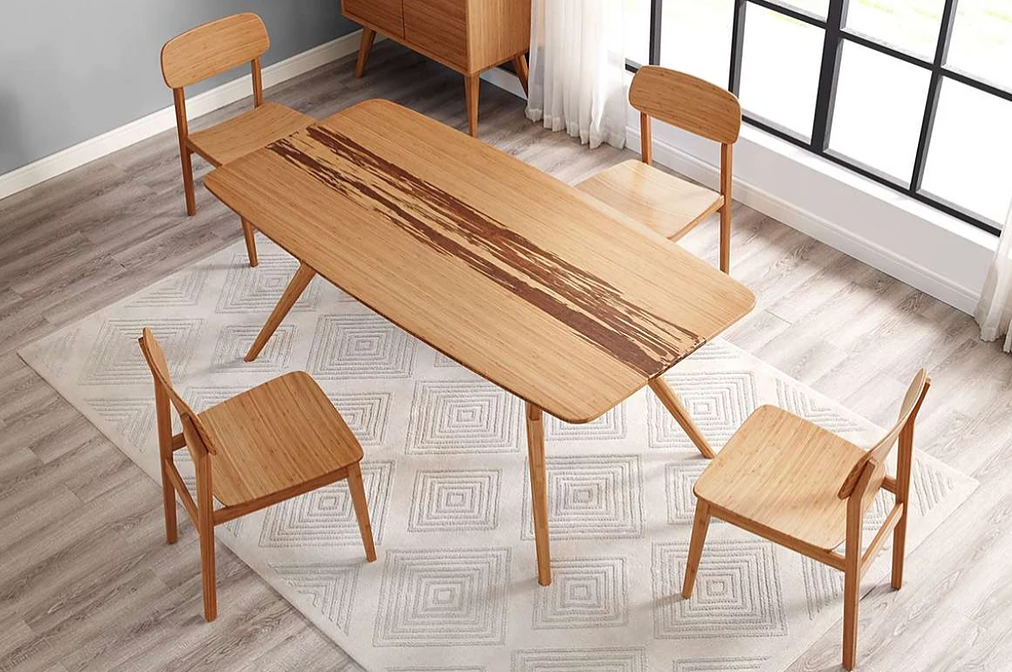
Kenneth Leather Chair from Lulu & Georgia and Azara Dining Table by SmartFurniture
Designer Josh Pickering expects the desire for custom-made furniture to continue through the end of the year. The designer expressed to House Beautiful that “so many new artisans and boutique furniture companies have come out recently.” These new designers have offered an antidote to the perennial sameness of fast furniture. Pickering expects this influx of new up-and-coming artisans to encourage more people to commission “more unique, one-of-a-kind pieces,” giving up “ready-made, mass-manufactured pieces.” Consumers are looking for pieces that are “unique, special” and sustainable.
One of our favorite expressions of this trend has been the Kenneth Leather Chair from Lulu & Georgia. Described as putting “a contemporary spin on a classic mid-century aesthetic,” the Kenneth Leather Chair is a beautiful touch. The piece is perfect for any homeowner searching for coastal modern furniture. Our other favorite in this category is the Azara Dining Table by SmartFurniture because of its thoughtful design. The Azara Dining Table “features modern architectural lines, great legs, and tabletop accent in the natural beauty of exotic tiger bamboo.” This makes the table incredibly sustainable, as bamboo is the “planet’s most eco-friendly and rapidly renewable resource.” Both can be found on Ocean Modern Home’s site.
Transitional, Indoor-Outdoor Coastal Modern Furniture Pieces


Safavieh Table from Bloomingdale’s and Marina Hanging Chair by Arhaus
Hadley Keller notes in her article “Six Furniture Trends” for House Beautiful, that one exciting trend is the blurring of interior and exterior. Coastal modern furniture — especially — can easily transition from the patio or deck to the living room or kitchen. Keller explains that “performance and outdoor fabrics and the surge in new outdoor lines” have made outdoor furniture more flexible. This 2020 interiors trend is perfect for the coast. It is especially apt as adoption of the mid-century modern design ideal of blending indoor spaces with outdoor spaces increases. Soaring windows and other biophilic design elements are being celebrated across the country by designers and consumers alike. As bad weather — snow, sleet, hail, and rain — rolls in, spending time outside might be curtailed. Fortunately, bringing the outdoors in with your patio furniture can freshen up the space.
Our favorite expressions of this trend have been the Safavieh Table from Bloomingdale’s and the Marina Hanging Chair by Arhaus. The Safavieh Table is perfect for this section, described as an “indoor/outdoor modern concrete oval coffee table.” Both can be found on Ocean Modern Home’s site.
Concentrated Colors, Luxe Materials, and Punchy Prints

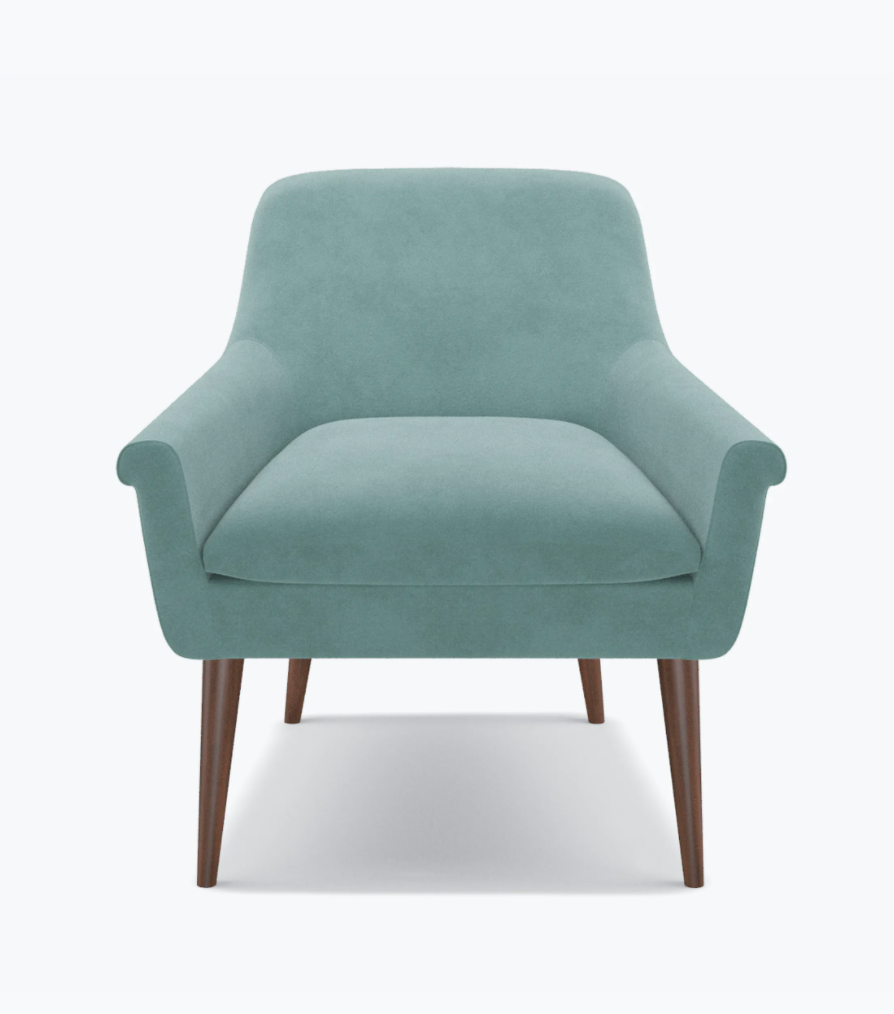
Topanga Sofa from Jonathan Adler, Shop Here and Aqua Cocktail Chair from The Inside, Shop Here
In his article for Architectural Digest, Nash expects bold colors, patterns, and prints to continue their reign through the end of 2020. Nash interviewed Katy Polsby of CW Stockwell and Suzanne Tucker of Tucker & Marks Designs to support his theory. Polsby has found that “patterned and brightly-colored furnishings” will not be going anywhere as the year closes out. The drab, neutral palettes of typical Fall and Winter decor are unlikely to find a hold this year. Their prevalence is especially unlikely with people still cooped up and looking for visual stimulation. Patterns referencing nature have been CW Stockwell’s most frequently purchased fabrics this year, with leaf green, coral, and navy “among the most popular offerings.” For Fall and Winter, we can expect a shift towards luxe, deeply colored materials like velvet, Tucker remarks.
Our favorite expressions of this trend have been the Topanga Sofa from Jonathan Adler and the Aqua Cocktail Chair from The Inside. Both are featured on Ocean Modern Home’s site. Consider the Blush Velvet or Moss Velvet upholstery options for the cocktail chair to transition from Summer to Fall and into the Winter months.
Organic Shapes

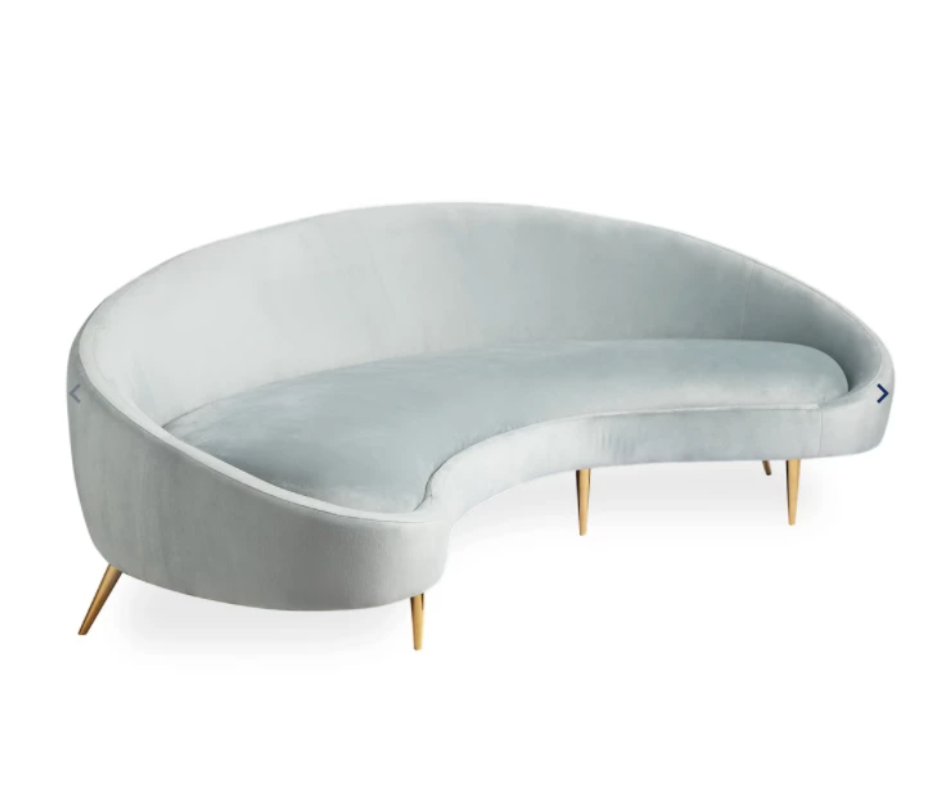
Grace Serpentine – Anthropologie, Shop Here and Ether Curved Sofa – Jonathan Adler, Shop Here
The organic shapes interior trend has taken over 2020 — from furniture to framed prints and from rugs to mirrors. Trendbook explains in their article “Curved Shapes is a Huge Decor Trend for 2020,” that “the design style of the ’60s” has reemerged. The trend has made its way into every corner of high-design homes across the country, especially coastal modern homes. The primary goal with organic shapes is to pull nature in from the outdoors, with the secondary goal being to soften interiors overall.
This continued “softening of interiors with curvy shapes and organic, rounded edges” has interested more designers and homeowners over the years. The trend has held on especially as the coastal modern aesthetic has become more mainstream. Trendbook notes that “in the past few years, we have seen a lot of [furniture] with ruler-straight lines and sleek, simple contours.” The site explains that 2020 has cast those aside in favor of “furniture with non-symmetrical shapes and playful curves.”
Our favorite expressions of this trend have been the Grace Serpentine Sofa by Anthropologie and the Ether Curved Sofa from Jonathan Adler. Both are featured on Ocean Modern Home’s site.
